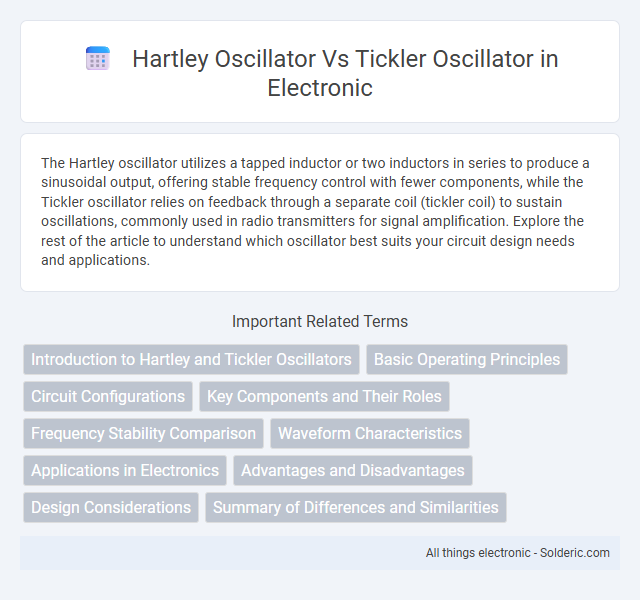The Hartley oscillator utilizes a tapped inductor or two inductors in series to produce a sinusoidal output, offering stable frequency control with fewer components, while the Tickler oscillator relies on feedback through a separate coil (tickler coil) to sustain oscillations, commonly used in radio transmitters for signal amplification. Explore the rest of the article to understand which oscillator best suits your circuit design needs and applications.
Comparison Table
| Feature | Hartley Oscillator | Tickler Oscillator |
|---|---|---|
| Oscillator Type | LC oscillator | LC oscillator |
| Feedback Mechanism | Tap on the inductor coil | Additional coil (tickler coil) providing feedback |
| Frequency Determination | Based on inductance taps and capacitor | Based on main coil, tickler coil inductances, and capacitor |
| Feedback Type | Inductive feedback via tapped coil | Inductive feedback via tickler coil |
| Construction Complexity | Simple, single coil with tap | More complex due to additional coil |
| Stability | Good frequency stability | Typically less stable due to coil coupling |
| Application | RF oscillator, signal generation | Regenerative receiver, signal amplification |
| Phase Shift | Provides 180deg phase shift | Provides 180deg phase shift |
Introduction to Hartley and Tickler Oscillators
Hartley oscillators utilize a tapped inductive coil in their resonant LC circuit to generate sinusoidal oscillations, providing frequency stability and ease of tuning. Tickler oscillators employ a regenerative feedback mechanism with a coil (tickler coil) magnetically coupled to the tank circuit, enhancing oscillation amplitude. Both oscillators serve in radio frequency applications but differ fundamentally in their feedback configurations and component arrangements.
Basic Operating Principles
The Hartley oscillator uses a tapped inductive coil or two inductors to provide feedback, generating sinusoidal waveforms by controlling the tank circuit oscillations. The tickler oscillator relies on a feedback coil known as the tickler coil, inductively coupled to the tank circuit, to sustain oscillations through self-excitation. Understanding these basic operating principles helps you choose the appropriate oscillator type for specific signal generation requirements in electronic circuits.
Circuit Configurations
The Hartley oscillator features a tank circuit with a single capacitor and a tapped inductor or two inductors in series, providing frequency determination and feedback through inductive coupling. The tickler oscillator uses a separate feedback winding, the "tickler coil," placed near the main inductor coil to induce feedback, ensuring sustained oscillations. Your choice between these configurations depends on the desired simplicity, tuning stability, and feedback control in oscillator design.
Key Components and Their Roles
The Hartley oscillator features a tapped inductive coil or two inductors in series with a capacitor, where the inductors determine the frequency of oscillation and the tap provides feedback. The tickler oscillator uses a separate feedback coil called the tickler coil, magnetically coupled to the tank coil, to supply regenerative feedback for sustained oscillations. In the Hartley design, feedback is derived directly from the inductive division, while in the tickler configuration, inductive coupling between coils facilitates the feedback mechanism.
Frequency Stability Comparison
The Hartley oscillator offers better frequency stability due to its use of a tapped inductor, which provides a fixed feedback ratio less susceptible to component variations. In contrast, the tickler oscillator, often relying on coil coupling for feedback, tends to experience more frequency drift as the coupling coefficient can change with temperature and component aging. Choose the Hartley oscillator for applications requiring consistent frequency performance over time.
Waveform Characteristics
Hartley oscillators produce a sinusoidal waveform characterized by a stable frequency determined by an LC tank circuit with a tapped inductor, ensuring low distortion and high purity in RF signal generation. Tickler oscillators, a variation of the Hartley design, utilize feedback through a "tickler" coil to sustain oscillations, often resulting in slightly less frequency stability but enhanced amplitude control. Your choice depends on whether waveform purity or feedback adjustability is more critical for the application.
Applications in Electronics
Hartley oscillators are widely used in radio frequency applications such as signal generators, RF transmitters, and local oscillators due to their stable sinusoidal output and ease of tuning. Tickler oscillators, often employed in audio frequency amplification and induction heating, rely on feedback through a coil (tickler winding) to sustain oscillations, making them suitable for magnetic field generation and low-frequency signal generation tasks. Your choice between these oscillators depends on the specific frequency range and application requirements in electronic circuit design.
Advantages and Disadvantages
The Hartley oscillator offers simplicity and easy frequency tuning due to its tapped coil design but suffers from limited amplitude stability and potential waveform distortion. The tickler oscillator provides stronger feedback and improved signal stability by using a separate feedback winding, yet it is more complex and prone to higher power consumption. Your choice depends on balancing ease of design with stability requirements and efficiency in the intended application.
Design Considerations
Hartley oscillators require a tapped inductor or two inductors to set the frequency, ensuring stable oscillations with minimal phase shift, while tickler oscillators utilize a feedback coil (tickler) to induce energy back into the tank circuit for sustained oscillations. You must consider inductance values, coil coupling, and Q-factor in Hartley designs, whereas tickler oscillators demand precise feedback coil positioning and coupling strength to maintain amplitude stability. Component tolerance and thermal stability greatly influence the performance and frequency accuracy of both oscillator types.
Summary of Differences and Similarities
The Hartley oscillator uses a tapped inductive coil to provide feedback, while the Tickler oscillator often employs a separate feedback coil (tickler coil) magnetically coupled to the main coil. Both oscillators operate on LC tank circuits and generate sinusoidal waveforms, relying on positive feedback to sustain oscillations. Your choice depends on circuit simplicity and feedback needs: Hartley offers a single coil with taps, whereas the Tickler configuration enables adjustable coupling through its separate feedback coil.
hartley oscillator vs tickler oscillator Infographic

 solderic.com
solderic.com